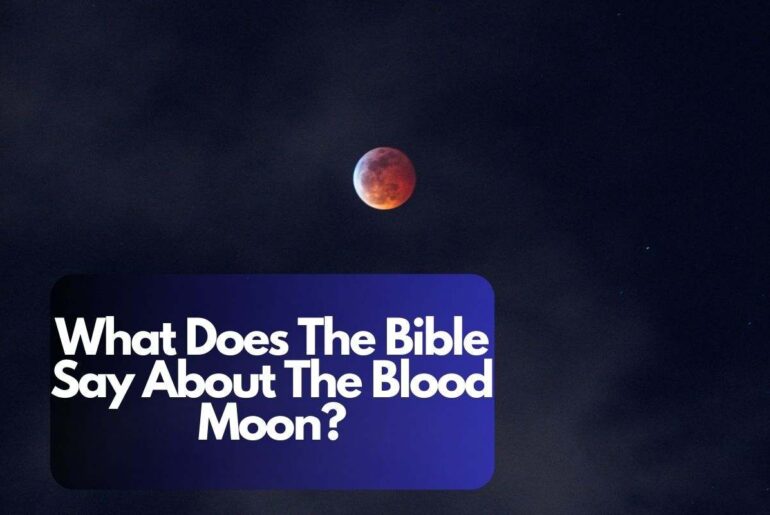The celestial wonders that grace our skies have always fascinated humanity, inspiring wonder, awe, and speculation. Among these astronomical phenomena, one that has captured attention throughout history is the Blood Moon. With its striking reddish hue during a lunar eclipse, the Blood Moon has sparked curiosity and generated interpretations across cultures and religious traditions. But what does the Bible, a foundational text for millions of believers, say about the Blood Moon?
In this exploration of the topic, we will delve into the biblical perspective on the Blood Moon, seeking to understand its significance, symbolism, and implications within the context of the sacred Scriptures. By examining biblical passages, ancient Hebrew culture, and theological interpretations, we will uncover insights that shed light on this captivating celestial event.
Contents
What Does The Bible Say About The Blood Moon?
The Bible mentions the term “blood moon” in a few instances, specifically in the context of celestial signs and the end times. In Joel 2:31, it states, “The sun shall be turned into darkness, and the moon into blood, before the great and awesome day of the Lord comes.” Similarly, in Acts 2:20, Peter quotes this passage from Joel, connecting it to the events surrounding the day of Pentecost.
These references to the moon turning into blood symbolize significant cosmic events that are associated with God’s judgment and the coming of the Lord. They are part of the signs and wonders that will occur in the last days. However, it’s important to note that these references are metaphorical and should not be interpreted as literal occurrences of blood moons.
Throughout the Bible, celestial events are often used to convey symbolic meaning, such as the darkening of the sun and moon. These passages emphasize the impending judgment of God and the need for repentance and spiritual preparation.
While the concept of blood moons may capture the interest and curiosity of individuals, it is crucial to approach these references in their intended metaphorical context. The Bible encourages believers to be vigilant and discerning about the signs of the times but also reminds us to focus on living in righteousness and being prepared for the return of the Lord rather than speculating about celestial events (Matthew 24:36-44).
Blood Moon is a term used to describe a lunar eclipse when the moon appears reddish or coppery in color. During a lunar eclipse, the Earth aligns between the sun and the moon, casting a shadow on the moon’s surface. The reddish appearance of the moon is caused by the scattering of sunlight through the Earth’s atmosphere, bending the light and filtering out shorter blue wavelengths while allowing longer red wavelengths to pass through. This gives the moon a reddish hue during a total lunar eclipse, hence the term “Blood Moon.”
Historical and cultural significance
Throughout history, celestial events have captivated human imagination and have been associated with various cultural and religious significances. The phenomenon of a Blood Moon has been observed and interpreted by different civilizations and cultures in diverse ways. In ancient times, people often attributed mystical and supernatural significance to celestial events, considering them as omens or signs from the divine realm. These events sometimes held cultural, religious, or even political implications, depending on the beliefs and practices of the time. The Blood Moon, with its striking appearance, has often captured the attention of people and sparked curiosity and speculation about its meaning.
Purpose of the content
Understanding the biblical perspective on the Blood Moon
The purpose of this content is to explore the biblical perspective on the Blood Moon phenomenon. The Bible, as a religious and historical text, contains passages that refer to celestial signs and events, including the moon. Understanding the biblical perspective on the Blood Moon can provide insights into its significance within the context of the Christian faith. By examining relevant biblical passages, interpreting their meaning, and exploring theological reflections, this content aims to shed light on how the Bible addresses the Blood Moon and what lessons or teachings can be derived from its mention. It seeks to offer a comprehensive understanding of the topic while considering different interpretations and viewpoints within the Christian tradition.
The Blood Moon in Biblical Prophecy
Reference to celestial signs in biblical prophecy
The Bible contains numerous passages that refer to celestial signs as part of prophetic messages. These signs often serve as indicators of significant events or periods in God’s plan for humanity. Celestial phenomena such as the darkening of the sun, the moon turning to blood, or stars falling from the sky are mentioned as signs that accompany or precede important divine interventions or the fulfillment of specific prophecies. These signs are intended to capture attention, evoke awe, and convey the gravity of the events unfolding.
Importance of the moon in biblical symbolism
In the Bible, the moon holds symbolic significance. It is often associated with the rhythms of time, seasons, and the appointed festivals. The moon’s waxing and waning cycles also symbolize change, transformation, and the ebb and flow of life. Moreover, the moon’s reflective nature has been linked to God’s provision of light in the night sky, contrasting with the greater brightness of the sun. Symbolically, the moon can represent God’s faithful presence, guidance, and illuminating grace in the darkness of life’s journey.
Specific references to the Blood Moon in prophetic passages
The term “Blood Moon” itself may not be explicitly mentioned in the Bible. However, there are prophetic passages that describe celestial events associated with a moon that appears red or darkened. One notable reference is found in the book of Joel 2:30-31, which states, “And I will show wonders in the heavens and on the earth, blood and fire and columns of smoke. The sun shall be turned to darkness, and the moon to blood, before the great and awesome day of the Lord comes.”
Another reference can be found in the book of Revelation 6:12, which depicts a vision of the opening of the sixth seal: “When he opened the sixth seal, I looked, and behold, there was a great earthquake, and the sun became black as sackcloth, the full moon became like blood.” This passage, along with other apocalyptic descriptions in Revelation, portrays celestial signs that accompany the end times and the culmination of God’s judgment and redemption.
These references to the moon turning to blood, along with other celestial phenomena, symbolize significant events and changes in the divine plan, signaling moments of divine intervention, judgment, or the arrival of the eschatological age. While the precise interpretation of these passages may vary among biblical scholars and theologians, they all emphasize the cosmic and supernatural nature of the events being described.
Blood Moons in the Old Testament
Examination of lunar events in the Old Testament
The Old Testament contains references to various lunar events and celestial occurrences. These passages describe phenomena such as eclipses, new moons, and full moons. While not specifically using the term “Blood Moon,” these accounts provide insights into the understanding of lunar events within the ancient Hebrew culture and their potential significance.
Examples of significant events associated with the moon
1. Passover: The festival of Passover, commemorating the Israelites’ liberation from slavery in Egypt, is closely tied to the lunar calendar. The timing of Passover is determined by the appearance of the first full moon of spring, often referred to as the “Paschal Moon.”
2. Festivals and feasts: The Hebrew calendar included various festivals and feasts, such as the Feast of Trumpets, the Day of Atonement, and the Feast of Tabernacles. These events were often scheduled to align with specific phases of the moon, emphasizing the connection between the lunar cycle and religious observances.
Symbolism and interpretations of lunar events in ancient Hebrew culture
In ancient Hebrew culture, the moon held symbolic significance beyond its practical and astronomical aspects. The moon was often associated with femininity, fertility, and cycles of life. It symbolized the passage of time, the rhythm of seasons, and the ordered patterns of God’s creation.
Ancient Hebrew culture also attributed spiritual and metaphorical meanings to the moon. It was seen as a reflection of God’s glory and a reminder of His faithfulness. The moon’s cycles of waxing and waning were associated with the ups and downs of human existence and the constant need for renewal and restoration.
Interpretations of lunar events in the Old Testament may vary among scholars, and it is important to approach these cultural understandings with respect to the historical context in which they emerged. The Old Testament’s accounts of lunar events provide a glimpse into the ancient Hebrew perspective on the moon’s significance, helping us better understand their worldview and how they related to the celestial realm.
The Blood Moon in the New Testament
Mention of the Blood Moon in the teachings of Jesus
In the New Testament, Jesus refers to celestial signs, including the darkening of the sun and the moon turning to blood, in his teachings about the end times. In the Gospel of Matthew 24:29, Jesus says, “Immediately after the tribulation of those days, the sun will be darkened, and the moon will not give its light, and the stars will fall from heaven, and the powers of the heavens will be shaken.” While Jesus doesn’t explicitly use the term “Blood Moon,” his mention of the moon not giving its light can be interpreted as a reference to a darkened or blood-like appearance.
Interpretation of celestial signs in the book of Revelation
The book of Revelation, written by the apostle John, contains vivid and symbolic imagery of celestial signs associated with the end times. Revelation 6:12 describes the opening of the sixth seal, stating, “When he opened the sixth seal, I looked, and behold, there was a great earthquake, and the sun became black as sackcloth, the full moon became like blood.” This passage, along with other descriptions in Revelation, portrays cosmic disturbances and celestial signs as part of God’s judgment and the culmination of history.
These celestial signs in the book of Revelation are highly symbolic, conveying the idea of dramatic cosmic events that accompany the divine plan. They serve to emphasize the magnitude and significance of the eschatological events unfolding, rather than providing literal astronomical descriptions. The mention of the moon turning to blood in Revelation adds to the apocalyptic imagery, conveying a sense of awe, upheaval, and divine intervention.
Understanding the eschatological significance of the Blood Moon
The Blood Moon, within the context of eschatology (the study of the end times), symbolizes the cosmic signs and events that will occur as part of God’s final judgment and the culmination of His redemptive plan. The darkening or reddening of the moon signifies the great cosmic upheaval and divine intervention associated with the return of Christ and the establishment of His kingdom.
While the precise interpretation of the eschatological significance of the Blood Moon may vary among theologians, it is generally understood as a symbol of the imminent and dramatic events that will accompany the final judgment and the ultimate fulfillment of God’s purposes. The mention of the Blood Moon in both the teachings of Jesus and the book of Revelation underscores its symbolic importance within the eschatological framework of Christianity.
It is important to approach these eschatological interpretations with humility and recognize that there are different theological perspectives within Christianity regarding the specific timing, sequence, and symbolism of end-time events. The Blood Moon serves as a symbol that invites believers to be watchful, prepared, and attentive to the signs of the times, as they anticipate the consummation of God’s plan for redemption and restoration.
Different Interpretations of the Blood Moon
Various religious and theological perspectives
The interpretation of the Blood Moon varies across different religious and theological perspectives. Religions such as Christianity, Judaism, and Islam may have their own understandings and interpretations of celestial phenomena, including the Blood Moon. These perspectives are shaped by the teachings, scriptures, and cultural beliefs of each religion.
Interpretations within Christianity
1. Dispensationalist Interpretation: Some Christians who follow a dispensationalist approach to biblical prophecy view the Blood Moon as a literal sign of the end times. They believe that celestial events, including the Blood Moon, align with specific prophetic events outlined in Scripture, indicating the imminent return of Christ and the events described in the book of Revelation.
2. Historicist Interpretation: Within the historicist interpretation, certain Christians see the Blood Moon as symbolic rather than literal. They view it as representing significant historical events or periods within the church’s history, rather than specific future events. These interpretations seek to find correspondences between celestial signs and historical occurrences.
3. Symbolic Interpretation: Some Christians interpret the Blood Moon symbolically, emphasizing its spiritual significance rather than focusing on literal or future events. They see it as a reminder of God’s covenant, the atoning work of Christ, or the need for repentance and spiritual renewal. The Blood Moon is understood as a metaphorical sign pointing to deeper theological truths rather than predicting specific future events.
Comparison with non-Christian interpretations
1. Astrological Interpretation: In astrology, the Blood Moon is often associated with astrological phenomena and is believed to have various effects on individuals and the world. Astrologers assign specific meanings and influences to different lunar phases, including the Blood Moon, based on their understanding of celestial energies and planetary alignments. These interpretations are not rooted in religious or biblical frameworks.
2. Folklore Interpretation: In different cultures, folklore and traditions have attached their own meanings and interpretations to celestial events like the Blood Moon. These interpretations can vary widely, ranging from omens of good or bad fortune to supernatural or magical associations. Folklore interpretations often reflect local beliefs, customs, and cultural narratives rather than specific religious or theological doctrines.
It is important to note that while non-Christian interpretations may provide insights into different cultural perspectives, they do not necessarily align with the biblical understanding of the Blood Moon within a Christian context. Christians generally derive their interpretations from biblical teachings and theological frameworks.
Theological and Spiritual Reflections
Symbolic meanings attributed to the Blood Moon in Christianity
Within Christianity, the Blood Moon carries symbolic meanings that invite theological and spiritual reflection. Some symbolic interpretations include:
1. Redemption and Atonement: The red or blood-like appearance of the moon can symbolize the sacrificial death of Jesus Christ and His atoning work on the cross. It serves as a reminder of God’s redemption and the forgiveness of sins made possible through Christ’s shed blood.
2. Judgment and Warning: The darkened or reddened moon can also symbolize God’s judgment and the need for repentance. It serves as a reminder of the consequences of sin and the urgency to turn to God.
3. Eschatological Hope: The Blood Moon can symbolize the anticipation of the return of Christ and the fulfillment of God’s promises. It points to the hope of the future resurrection, final judgment, and the establishment of God’s kingdom.
Lessons and teachings associated with the Blood Moon
1. Watchfulness and Preparedness: The mention of celestial signs, including the Blood Moon, in biblical texts teaches believers to be watchful and prepared for the coming of Christ and the final judgment. It encourages a vigilant and faithful posture in anticipation of God’s ultimate purposes.
2. Faith and Trust in God’s Promises: The symbolism of the Blood Moon reminds Christians of the faithfulness of God and His fulfillment of His promises throughout history. It invites believers to trust in God’s sovereignty, even in times of uncertainty or cosmic upheaval.
3. Reflection and Repentance: The Blood Moon can serve as a call for self-reflection, repentance, and a renewal of faith. It prompts believers to examine their lives, align them with God’s will, and seek forgiveness and reconciliation with God and others.
Relevance of the Blood Moon in contemporary Christian thought and practice
The Blood Moon continues to hold relevance in contemporary Christian thought and practice in various ways:
1. Spiritual Discernment: The mention of celestial signs, including the Blood Moon, encourages Christians to cultivate spiritual discernment. It prompts believers to discern the signs of the times, evaluate their own spiritual condition, and seek guidance from God’s Word and the Holy Spirit.
2. Hope and Anticipation: The symbolism of the Blood Moon inspires hope and anticipation among believers. It reminds them that, despite the challenges and tribulations of life, the redemptive work of Christ and the fulfillment of God’s promises are certain.
3. Prayer and Intercession: The mention of celestial signs can prompt Christians to engage in prayer and intercession. It invites believers to pray for God’s mercy, guidance, and protection, both for themselves and for the world, as they navigate through times of change and uncertainty.
Scientific Explanation of the Blood Moon Phenomenon
Astronomical causes of a Blood Moon
A Blood Moon is a phenomenon that occurs during a lunar eclipse. A lunar eclipse happens when the Earth aligns between the Sun and the Moon, casting a shadow on the Moon. The reddish appearance of the Moon during a lunar eclipse is caused by the Earth’s atmosphere bending and filtering sunlight, resulting in certain wavelengths of light, primarily red and orange, being refracted onto the Moon’s surface.
Lunar eclipses and their occurrence
Lunar eclipses occur when the Earth, Moon, and Sun align in a specific way. There are three types of lunar eclipses: total, partial, and penumbral. During a total lunar eclipse, the Earth’s shadow completely covers the Moon, giving it a reddish hue. Partial lunar eclipses occur when only a portion of the Moon passes through the Earth’s shadow, while penumbral lunar eclipses happen when the Moon moves through the Earth’s outer shadow, resulting in a subtle darkening of the Moon’s brightness.
Lunar eclipses are relatively common astronomical events. They can occur up to three times in a year but are not visible from every location on Earth during each occurrence. The visibility of a lunar eclipse depends on the Moon’s position in its orbit and the observer’s geographic location.
Understanding the red hue of the moon during a lunar eclipse
When sunlight passes through the Earth’s atmosphere, it undergoes a process called atmospheric scattering. The Earth’s atmosphere scatters shorter wavelengths of light, such as blue and green, more strongly than longer wavelengths, such as red and orange. As a result, during a lunar eclipse, when sunlight passes through the Earth’s atmosphere, most of the shorter wavelengths get scattered away, and the longer wavelengths bend or refract towards the Moon, giving it a reddish appearance.
The exact color and intensity of the red hue can vary depending on various factors, such as the amount of dust and particles in the Earth’s atmosphere at the time of the eclipse. These factors can influence the overall appearance of the Blood Moon during a lunar eclipse.
VIII. Conclusion
The topic of the Blood Moon is vast and multifaceted, encompassing religious, cultural, scientific, and historical dimensions. It serves as a starting point for your exploration and understanding. I encourage you to delve deeper into the subject by studying specific biblical passages, consulting theological resources, and exploring scientific literature on lunar eclipses and celestial events. Further research will provide a more comprehensive understanding of the topic and allow you to form your own informed perspective. While interpretations may vary among individuals and theological traditions, the Blood Moon serves as a reminder of God’s faithfulness, the need for repentance, and the assurance of His promises. It calls believers to live with hope, trust in God’s sovereignty, and engage in prayer and intercession as they navigate through the challenges of life.
May your continued study and reflection on the Blood Moon deepen your faith and inspire a greater appreciation for God’s creation, His redemptive work, and His eternal plan.








